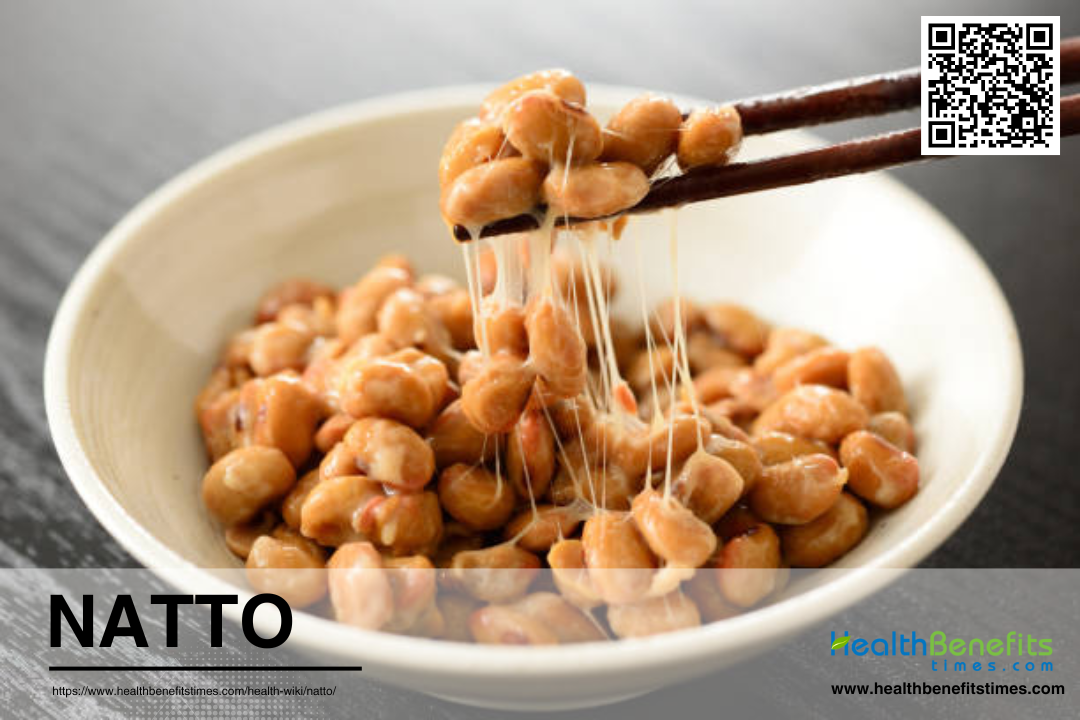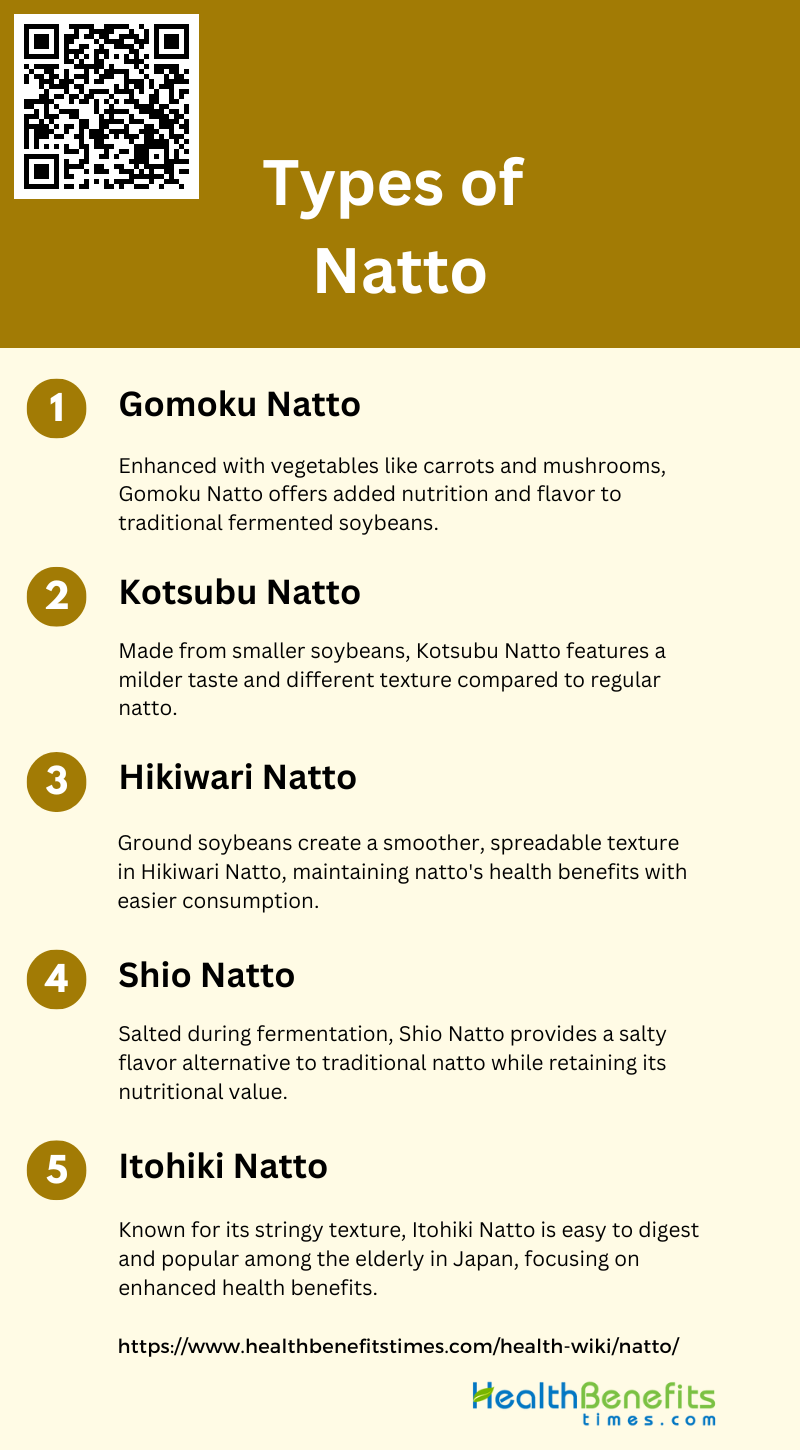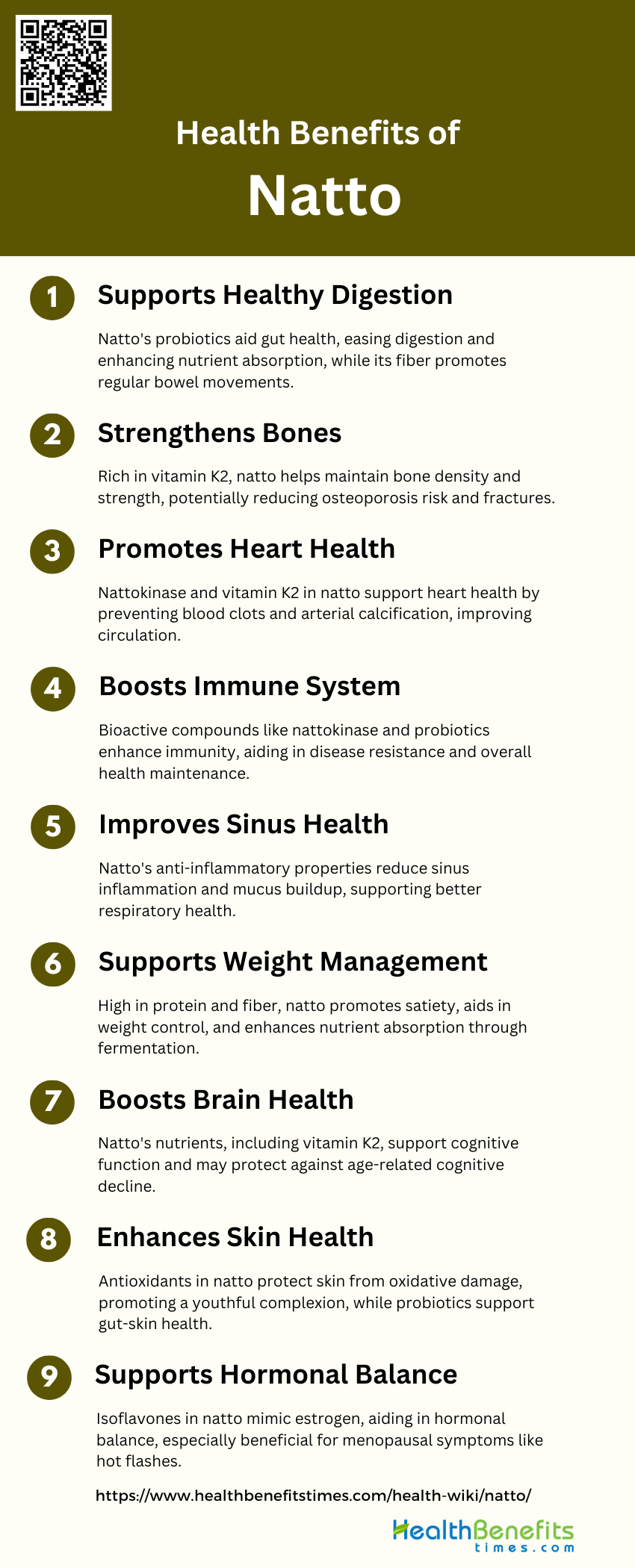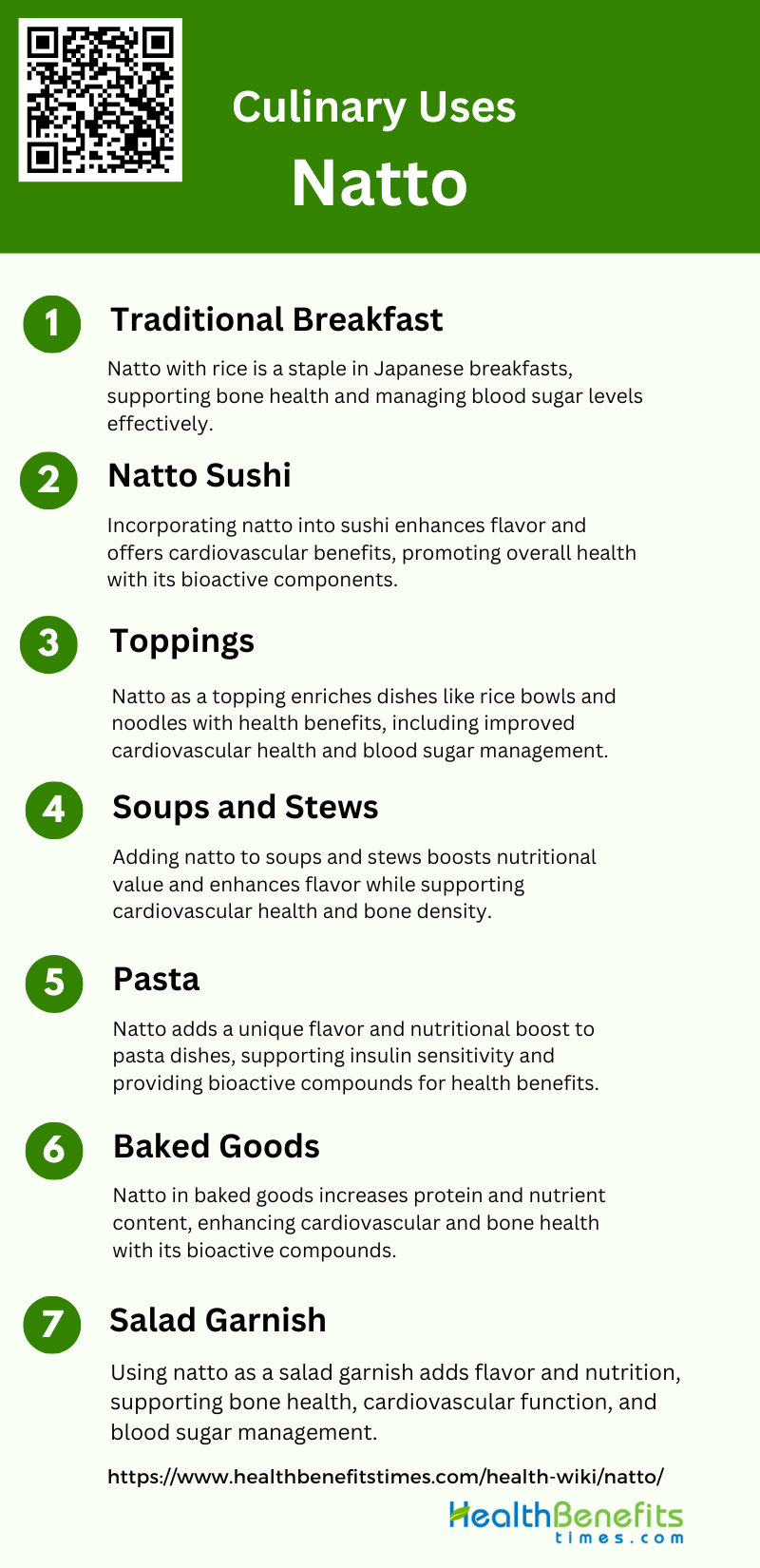Natto is a traditional Japanese food made from fermented soybeans. It is produced by fermenting boiled soybeans with the bacterium Bacillus subtilis natto, which gives natto its distinctive sticky texture and strong aroma. Natto has been consumed in Japan for over a thousand years and is considered a healthy addition to the diet due to its high nutritional value and potential health benefits. One of the key components of natto is the enzyme nattokinase, which has fibrinolytic (anti-clotting) properties and may help improve circulation and promote cardiovascular health. Natto is also a good source of protein, vitamins, and minerals, and contains beneficial compounds like isoflavones and probiotics from the fermentation process.
Types of Natto
Natto, a traditional Japanese food made from fermented soybeans, comes in various forms, each offering unique textures and flavors. Whether you prefer a stickier consistency or a milder taste, there’s a type of natto to suit your palate. Here are some common varieties:
1. Gomoku Natto
Gomoku Natto is a variation of traditional natto that incorporates a mix of vegetables and other ingredients, enhancing its nutritional profile and flavor. This type of natto is often prepared by adding finely chopped vegetables such as carrots, mushrooms, and burdock root, along with other seasonings, to the fermented soybeans. The addition of these ingredients not only improves the taste but also increases the fiber and vitamin content, making it a more balanced and healthful option. The fermentation process, driven by Bacillus subtilis, remains the same, ensuring that Gomoku Natto retains the beneficial properties of nattokinase and other bioactive components.
2. Kotsubu Natto
Kotsubu Natto, also known as small bean natto, is made using smaller soybeans compared to the regular natto. The smaller size of the beans results in a different texture and a milder flavor, which can be more appealing to some consumers. The fermentation process is similar to that of traditional natto, involving Bacillus subtilis, which produces beneficial enzymes like nattokinase. The smaller beans are easier to mix and consume, making Kotsubu Natto a convenient option for those who may find regular natto too sticky or strong in flavor.
3. Hikiwari Natto
Hikiwari Natto is made by grinding soybeans before fermenting them, resulting in a smoother texture and a more uniform consistency. This type of natto is particularly popular among those who prefer a less sticky and more spreadable product. The grinding process breaks down the soybeans, which can enhance the fermentation process and potentially increase the bioavailability of nutrients. Hikiwari Natto retains all the health benefits of traditional natto, including the presence of nattokinase and other bioactive compounds, while offering a different sensory experience.
4. Shio Natto
Shio Natto, or salted natto, is a variation that incorporates salt into the fermentation process. This type of natto has a distinct salty flavor, which can make it more palatable for those who are not accustomed to the strong taste of traditional natto. The addition of salt can also act as a preservative, potentially extending the shelf life of the product. Despite the change in flavor, Shio Natto still contains the beneficial enzymes and bioactive components produced by Bacillus subtilis during fermentation, making it a nutritious option.
5. Itohiki Natto
Itohiki Natto is characterized by its stringy texture, which is a result of the fermentation process involving Bacillus subtilis. This type of natto is particularly popular among the elderly in Japan, as it is easy to consume and digest. Recent developments have focused on creating Itohiki Natto that caters specifically to the nutritional needs of older adults, including modifications in the soybeans used and the fermentation process to enhance its health benefits. The stringy texture is due to the production of exopolysaccharides, which also contribute to its probiotic properties.
Nutritional value of Natto
Here’s a breakdown of its nutritional value per 100 grams:
- Calories: Approximately 212 kcal
- Fat: 11 grams
- Carbs: 14 grams
- Fiber: 5 grams
- Protein: 18 grams
- Manganese: 1.5 mg (75% of the Daily Value)
- Iron: 8.6 mg (48% of the Daily Value)
- Copper: 0.3 mg (34% of the Daily Value)
- Vitamin K: 23.1 µg (29% of the Daily Value)
- Magnesium: 115 mg (29% of the Daily Value)
- Calcium: 90 mg (9% of the Daily Value)
- Vitamin C: 13 mg (14% of the Daily Value)
- Potassium: 729 mg (21% of the Daily Value)
- Zinc: 3 mg (27% of the Daily Value)
- Selenium: 13.4 µg (24% of the Daily Value)
Health Benefits of Natto
Here are some of the key health benefits of natto:
1. Supports Healthy Digestion
The fermentation process of natto involves Bacillus subtilis, which helps in breaking down the soybeans, making them easier to digest and enhancing nutrient absorption. Probiotics in natto can help maintain a healthy balance of gut flora, which is crucial for proper digestion and preventing gastrointestinal issues. Additionally, the fiber content in natto aids in regular bowel movements and prevents constipation.
2. Strengthens Bones
Studies have shown that regular consumption of natto is associated with higher bone mineral density (BMD) and reduced bone loss in postmenopausal women, potentially preventing osteoporosis. The high vitamin K2 content in natto helps in maintaining bone strength and reducing the risk of fractures.
3. Promotes Heart and Circulatory Health
This enzyme, along with the high levels of vitamin K2, contributes to cardiovascular health by preventing arterial calcification and promoting healthy blood circulation. Studies suggest that regular intake of natto may reduce the risk of coronary heart disease (CHD) and improve vascular health by inhibiting the calcification of arteries.
4. Strengthen Your Immune System
The fermentation process enhances the bioavailability of these compounds, making them more effective in supporting the immune system. Additionally, the probiotics in natto help maintain a healthy gut microbiome, which is closely linked to immune function. Regular consumption of natto can help strengthen the body’s natural defenses against infections and diseases.
5. Improved Sinus Health
The presence of nattokinase in natto helps in reducing mucus build-up and inflammation in the nasal passages, which can alleviate symptoms of sinusitis. Additionally, the probiotics in natto support overall immune health, which can help in preventing and managing sinus infections. Regular consumption of natto may lead to fewer sinus issues and better respiratory health.
6. Promotes Weight Management
The high protein content helps in promoting satiety, reducing overall calorie intake, and supporting muscle maintenance. Additionally, the fiber in natto aids in digestion and helps in maintaining a healthy weight. The fermentation process also enhances the bioavailability of nutrients, making natto a nutrient-dense food that supports overall health and weight management.
7. Brain Health Boost
Vitamin K2 helps in the synthesis of sphingolipids, which are essential components of brain cell membranes. Additionally, the anti-inflammatory properties of natto can help in reducing the risk of neurodegenerative diseases. Regular consumption of natto may support cognitive function and protect against age-related cognitive decline.
8. Improve Skin Health
The antioxidants present in natto, such as isoflavones and phenolic acids, help in protecting the skin from oxidative stress and damage caused by free radicals. These antioxidants can reduce the signs of aging, such as wrinkles and fine lines, and promote a healthy, youthful complexion. Additionally, the probiotics in natto support gut health, which is closely linked to skin health. A healthy gut can lead to clearer, healthier skin.
9. Supports Hormonal Balance
This can be particularly beneficial for women experiencing hormonal imbalances, such as those going through menopause. Isoflavones can help in alleviating symptoms of menopause, such as hot flashes and mood swings, by providing a natural source of estrogen. Regular consumption of natto can support hormonal balance and improve overall well-being.
Culinary Uses Natto
Its distinctive texture and rich nutritional profile make it a popular ingredient in both traditional and modern recipes. Here are some common culinary uses of natto:
1. Traditional Breakfast
This combination has been shown to improve insulin sensitivity and lipid metabolism, particularly in individuals with impaired glucose tolerance. The inclusion of natto in breakfast meals can reduce postprandial glucose and insulin levels, making it a beneficial choice for managing blood sugar levels. Additionally, natto’s high content of menaquinone-7, a form of vitamin K2, contributes to bone health, which is particularly beneficial for postmenopausal women. The unique texture and flavor of natto, combined with its health benefits, make it a popular choice for a nutritious start to the day.
2. Natto Sushi
The sticky texture of natto pairs well with sushi rice and seaweed, creating a unique flavor profile. Natto’s bioactive components, such as nattokinase and vitamin K2, offer cardiovascular benefits by promoting blood clot dissolution and improving bone health. Additionally, natto’s potential to inhibit viral infections, including SARS-CoV-2, adds an extra layer of health benefits to this dish. Natto sushi not only provides a delicious culinary experience but also contributes to overall health and well-being.
3. Toppings
It can be added to rice bowls, noodles, and even toast. The bioactive compounds in natto, such as nattokinase and isoflavones, offer numerous health benefits, including improved cardiovascular health and reduced oxidative stress. Additionally, natto’s polysaccharides have been shown to suppress hyperglycemia, making it a beneficial addition for those managing blood sugar levels. Using natto as a topping is an easy way to incorporate its health benefits into everyday meals.
4. Soups and Stews
Incorporating natto into soups and stews is a delicious way to enjoy its health benefits. The fermentation process of natto produces bioactive compounds like nattokinase and vitamin K2, which are beneficial for cardiovascular health and bone density. Adding natto to soups and stews can also enhance the dish’s nutritional profile, providing essential nutrients and improving overall health. The unique flavor and texture of natto can complement various ingredients, making it a versatile addition to many traditional and modern recipes.
5. Pasta
The health benefits of natto, such as improved insulin sensitivity and lipid metabolism, make it a nutritious choice for pasta lovers. Additionally, natto’s ability to inhibit viral infections and its high content of bioactive compounds like nattokinase and vitamin K2 further enhance its appeal as a healthy ingredient . Incorporating natto into pasta dishes can provide a flavorful and healthful dining experience.
6. Baked Goods
Its high content of bioactive compounds, such as nattokinase and menaquinone-7, offers cardiovascular and bone health benefits. Adding natto to bread, muffins, or other baked items can enhance their protein content and provide additional health benefits. The unique flavor of natto can add an interesting twist to traditional baked goods, making them not only more nutritious but also more flavorful. This innovative use of natto can help incorporate its health benefits into a wider range of dietary options.
7. Salad Garnish
Using natto as a salad garnish is an excellent way to add both flavor and nutrition to salads. The bioactive components in natto, such as isoflavones and vitamin K2, contribute to improved bone health and cardiovascular function. Additionally, natto’s polysaccharides can help manage blood sugar levels, making it a beneficial addition for those with diabetes or insulin resistance. The unique texture and taste of natto can complement various salad ingredients, providing a nutritious and delicious garnish that enhances the overall health benefits of the dish.
Tips for first-timers trying Natto
Natto can be an acquired taste for many. If you’re trying it for the first time, there are several strategies to make the experience more enjoyable. Here are some tips to help you get started:
1. Start with Small Portions: Begin with a small amount to gradually get accustomed to its taste and texture.
2. Mix Well with Condiments: Stir natto thoroughly and add condiments like soy sauce, mustard, or green onions to enhance the flavor.
3. Pair with Rice: Serve natto over steamed rice to balance its strong taste.
4. Try Natto with Other Ingredients: Combine natto with ingredients like avocado, kimchi, or raw egg for a more complex flavor profile.
5. Consider Toasted or Cooked Natto: Toasting or lightly cooking natto can mellow its flavor and reduce its stickiness.
6. Season Well: Don’t hesitate to season natto with your favorite spices or sauces to make it more palatable.
7. Be Open-Minded: Keep an open mind and give yourself time to adjust to natto’s unique characteristics.
How to make Natto at home?
Making Natto at home is a rewarding process that involves fermenting soybeans with a specific strain of bacteria. This traditional Japanese dish is known for its unique flavor and texture, as well as its health benefits. Follow these steps to create your own Natto:
1. Soak the Soybeans: Rinse the soybeans thoroughly and place them in a large bowl. Cover the soybeans with plenty of water and let them soak for 12-18 hours. The beans will expand, so ensure they are well-covered.
2. Cook the Soybeans: Drain the soaked soybeans and place them in a large pot. Add enough water to cover the beans and bring to a boil. Reduce the heat and simmer for 4-5 hours, or until the beans are soft. Alternatively, you can use a pressure cooker to cook the beans faster (about 45 minutes).
3. Prepare the Fermentation Container: Sterilize the fermentation container by boiling it in water or using a dishwasher with a sterilize setting.
4. Inoculate the Soybeans: Drain the cooked soybeans and place them in the sterilized fermentation container. Dissolve the natto starter culture in a small amount of water (as per the instructions on the starter culture package) and mix it thoroughly with the soybeans.
5. Fermentation: Spread the soybeans evenly in the container and cover it with a lid or plastic wrap. Poke a few holes in the plastic wrap to allow air circulation. Place the container in an incubator or a warm place where the temperature is maintained at around 100°F (38°C). Let the soybeans ferment for 24-48 hours. You will notice a distinct smell and a sticky, stringy texture forming around the beans.
6. Aging: After fermentation, transfer the natto to the refrigerator and let it age for 1-2 days. This helps to develop the flavor further.
7. Storage: Store the natto in the refrigerator. It can be kept for about a week. For longer storage, you can freeze it.
Health Risks of Natto
Natto is known for its health benefits but also poses some health risks that should be considered. Here is the potential health risks associated with natto consumption:
1. High Sodium Content
Excessive sodium intake is associated with increased risks of hypertension, cardiovascular diseases, and stroke. While natto is beneficial for bone health due to its high vitamin K2 content, individuals consuming it regularly should be cautious about their overall sodium intake to avoid potential health risks. Monitoring and balancing sodium consumption from other dietary sources is crucial to mitigate these risks.
2. Vitamin K2 Interaction
Natto is rich in vitamin K2 (menaquinone-7), which plays a significant role in bone metabolism and cardiovascular health. However, this high vitamin K2 content can interact with anticoagulant medications like warfarin, potentially reducing their efficacy. Patients on warfarin therapy should be cautious with natto consumption, as it can lead to increased serum vitamin K levels, thereby antagonizing the effects of the medication and complicating anticoagulant management.
3. Allergic Reactions
Although the fermentation process in natto reduces the immunoreactivity of soybean proteins, there are still cases of allergic reactions, including late-onset anaphylaxis. Individuals with a known soybean allergy should be cautious when consuming natto, as it can trigger severe allergic responses. Reports have documented instances of anaphylaxis occurring several hours after ingestion, highlighting the need for awareness and caution among those with soy allergies.
4. Gastrointestinal Issues
The fermentation process produces various compounds that may cause digestive discomfort, such as bloating, gas, and diarrhea. These symptoms are often due to the high fiber content and the presence of specific bacteria used in fermentation. Individuals with sensitive digestive systems or those unaccustomed to fermented foods should introduce natto gradually into their diet to minimize gastrointestinal disturbances.
5. Histamine Intolerance
Fermented foods like natto can contain high levels of histamine, which may pose a risk for individuals with histamine intolerance. Histamine intolerance can lead to symptoms such as headaches, hives, abdominal pain, and flushing. People with this condition should be cautious with natto consumption and monitor their symptoms closely. Consulting with a healthcare provider can help manage and mitigate the effects of histamine intolerance.
6. Purine Content
High levels of uric acid can lead to gout, a form of arthritis characterized by severe pain and inflammation in the joints. Individuals with a history of gout or hyperuricemia should be mindful of their natto intake to avoid exacerbating their condition. Balancing natto consumption with other low-purine foods can help manage uric acid levels and reduce the risk of gout flare-ups.






